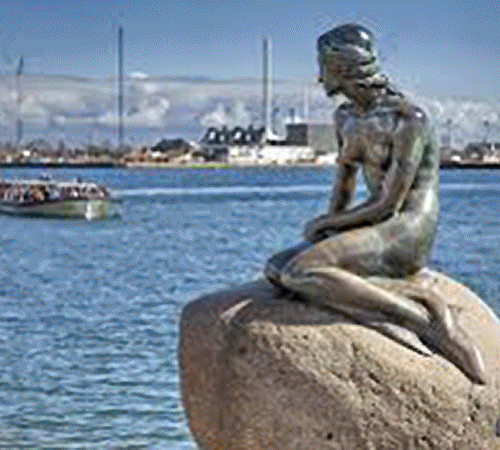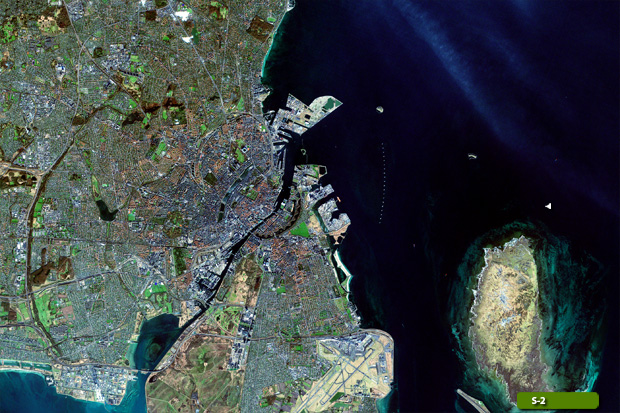|
Copenhagen, Denmark
Copenhagen is the capital and most populous city of Denmark. The city has a population of 775,033 (as of January 2018), of whom 613,288 live in the Municipality of Copenhagen. The larger urban area has a population of approximately 1.3 million (as of 1 January 2016), within the Capital Region of Denmark while the Copenhagen metropolitan area includes the closest part of Region Zealand and has over 2 million inhabitants. Copenhagen is situated on the eastern coast of the island of Zealand; another small portion of the city is located on Amager, and is separated from Malmö, Sweden, by the strait of Øresund. The Øresund Bridge connects the two cities by rail and road. Originally a Viking fishing village founded in the 10th century, Copenhagen became the capital of Denmark in the early 15th century. Beginning in the 17th century it consolidated its position as a regional centre of power with its institutions, defences and armed forces. After suffering from the effects of plague and fire in the 18th century, the city underwent a period of redevelopment. This included construction of the prestigious district of Frederiksstaden and founding of such cultural institutions as the Royal Theatre and the Royal Academy of Fine Arts. After further disasters in the early 19th century when Nelson attacked the Dano-Norwegian fleet and bombarded the city, rebuilding during the Danish Golden Age brought a Neoclassical look to Copenhagen's architecture. Later, following the Second World War, the Finger Plan fostered the development of housing and businesses along the five urban railway routes stretching out from the city centre. Since the turn of the 21st century, Copenhagen has seen strong urban and cultural development, facilitated by investment in its institutions and infrastructure. The city is the cultural, economic and governmental centre of Denmark; it is one of the major financial centres of Northern Europe with the Copenhagen Stock Exchange. Copenhagen's economy has seen rapid developments in the service sector, especially through initiatives in information technology, pharmaceuticals and clean technology. Since the completion of the Øresund Bridge, Copenhagen has become increasingly integrated with the Swedish province of Scania and its largest city, Malmö, forming the Øresund Region. With a number of bridges connecting the various districts, the cityscape is characterised by parks, promenades and waterfronts. Copenhagen's landmarks such as Tivoli Gardens, The Little Mermaid statue, the Amalienborg and Christiansborg palaces, Rosenborg Castle Gardens, Frederik's Church, and many museums, restaurants and nightclubs are significant tourist attractions. The largest lake of Denmark, Arresø, lies 43 kilometers northwest of the City Hall Square. Copenhagen is home to the University of Copenhagen, the Technical University of Denmark and Copenhagen Business School. The University of Copenhagen, founded in 1479, is the oldest university in Denmark. Copenhagen is home to the FC København and Brøndby football clubs. The annual Copenhagen Marathon was established in 1980. Copenhagen is one of the most bicycle-friendly cities in the world. The Copenhagen Metro launched in 2002 serves central Copenhagen while the Copenhagen S-train and Lokaltog (private railway) and the Coast Line network serves and connects central Copenhagen to outlying boroughs. To relieve traffic congestion, which is partly the result of increased traffic because of the Fehmarn Belt Fixed Link road and rail construction is planned because the narrow 9-9.5 mile isthmus between Roskilde Fjord and Køge Bugt (Køge Bay) forms a traffic bottleneck. The Copenhagen-Ringsted Line will relieve traffic congestion in the corridor between Roskilde and Copenhagen. Serving roughly two million passengers a month, Copenhagen Airport, Kastrup, is the busiest airport in the Nordic countries. More information is available on: Wikipedia

Our tour around the world in 2018 focuses over the city of Copenhagen today, as illustrated in these images acquired by the Sentinel-2 and Sentinel-1 satellites of the Copernicus programme. The capital of Denmark, Copenhagen City is composed of a major seaport and is the main commercial centre of the country. The greater part of Copenhagen lies on the eastern coast of Sjaelland Island and the smaller part, called Christianshavn, is on the Amager Island. These two sections of the city are connected by bridges. Copenhagen is near MalmÖ, Sweden, from which it is separated by the Øresund. As a constituent administrative district of Denmark, Copenhagen is governed by a body of elected municipal councillors and a group of magistrates appointed by the monarch. The image acquired by the Sentinel 2 satellite, clearly demonstrates the Middelgrunden offshore wind farm and a large area of algal bloom around the Saltholm Island. With this demonstration of images taken by the Sentinel-2 (optical sensor instrument) and Sentinel-1 (radar SAR instrument), we aim to show the large field of application that the Copernicus Sentinel satellite family can cover.   View Sentinel 2 high resolution image (JPG 11.4 MB) View Sentinel 1 high resolution image (JPG 6.7 MB)
|
|||||||||||||||||||

